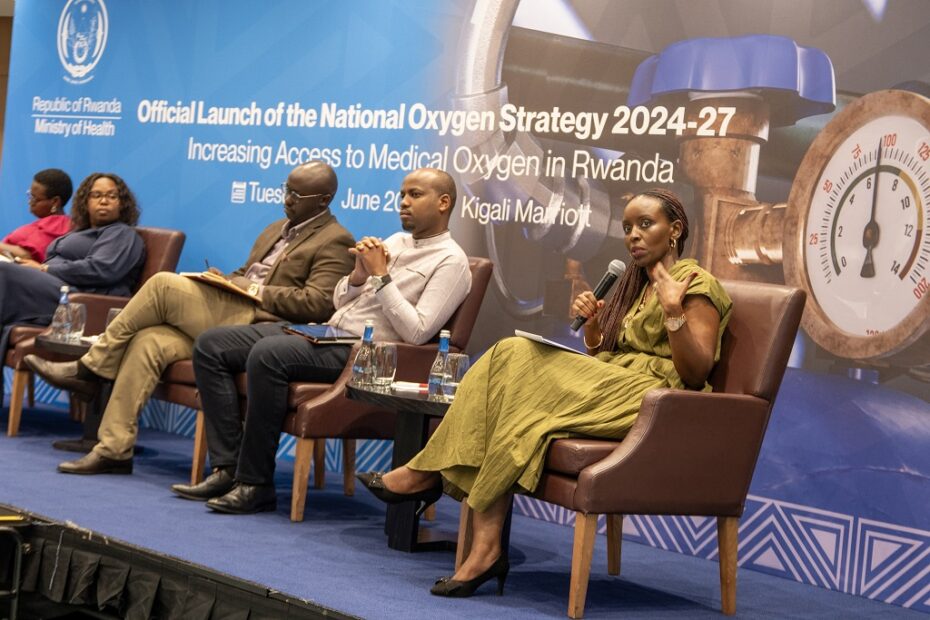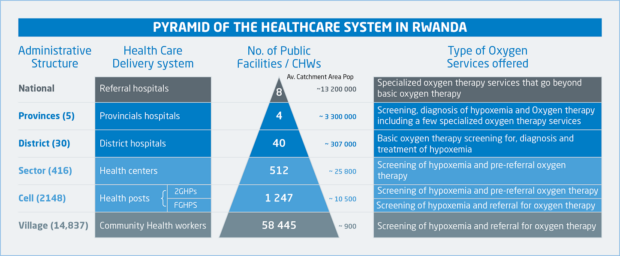Oxygen should be readily available to patients who need it, no matter where they are born or live. However, this is often not true in resource-poor countries such as Rwanda. Countries like Rwanda face challenges related to the availability of high-quality oxygen. They also frequently lack oxygen-related equipment and requisite accessories to aid delivery to the patient. This is further compounded by stretched human resource capacities. These gaps are greater in lower-level Primary Health Care (PHC) facilities, many of which have limited access to oxygen despite providing services and treatment to roughly 85 percent of diseases. Decentralization of oxygen access at this level is critical to healthcare service delivery.
To focus attention on the importance of oxygen, especially at this level, and provide a long-term vision for oxygen-related service delivery, the Rwanda Ministry of Health, supported by CHAI and other partners, developed and launched its National Oxygen Strategy (2024-2027) in June 2024. This strategy recognizes the changing oxygen landscape and the need for sustainable financing for oxygen. Most importantly, it recommends an implementation plan to address the aforementioned challenges. The strategy focuses on six key areas:
- An enabling policy environment
- Optimized production and distribution of oxygen
- Sustainable financing for oxygen
- Availability of delivery systems, diagnostics, and consumables
- Capacity building for healthcare and biomedical workers
- Improved data and information systems

At the community levels, healthcare providers should be able to screen and refer patients for oxygen therapy. PHCs will need to provide emergency pre-referral oxygen to ensure patients receive life-saving therapy at the point of need.

The government intends to equip PHC facilities and community level with equipment and training capabilities to detect and treat hypoxemic patients as pre-referral.
Changing the tide against oxygen shortage
Rwanda has significantly invested in improving oxygen access in the last few years. Since 2021, it has increased its national oxygen production capacity from 1.2 to 7.2 million m3 annually. The government has established 42 pressure swing adsorption (PSA) plants across 29 hospitals nationwide. This increase in the supply will ensure communities living in urban and rural areas can access this life-saving drug. In partnership with CHAI, the Ministry of Health has also trained 1653 healthcare workers with the tools and knowledge to identify and treat patients with low blood oxygen levels. The Ministry has procured pulse oximeters for hospitals; these are non-invasive devices that enable health workers to detect hypoxemia (dangerously low levels of oxygen in the blood). However, some significant gaps and challenges lie ahead, especially at PHC level, in ensuring these investments are maximized to reach all patients.
Ensuring the sustainability of oxygen availability in Rwanda
With a renewed focus on decentralizing oxygen at the PHC level, the Ministry will lead and oversee the strategy’s implementation at the national level. CHAI and other stakeholders will play different roles according to their expertise and interest in the oxygen ecosystem. Healthcare workers at this level must be appropriately equipped with the right diagnostic tools and equipment so they can detect and treat hypoxemia quickly. Additionally, the government, with partner support, must strengthen strategies and policies to ensure oxygen production equipment is maintained across its entire equipment lifespan. This will ensure oxygen can be sustainably produced for hospitals and PHCs without any interruption. The availability of equipment on its own is not sufficient. The Ministry of Health must continuously optimize its oxygen and consumables supply chain to generate cost and time-saving efficiencies.
With partner support, the MoH will train and mentor healthcare workers at lower levels of care to develop clinical skills capacity. It will also introduce oxygen therapy into relevant pre-service and in-service trainings, mentorships, and supportive supervisions, to sustain knowledge and quality of care.
The MoH and CHAI are paving the way to increasing oxygen access at primary healthcare levels. We have begun training healthcare workers to ensure they can diagnose and treat low blood oxygen. Much work still needs to be done in other areas, such as ensuring oxygen and equipment availability.
However, with increased strategic investments by partners and the Ministry of Health, we can ensure that the Rwandan population has access to this life-saving medicine and no child dies due to lack of oxygen.





